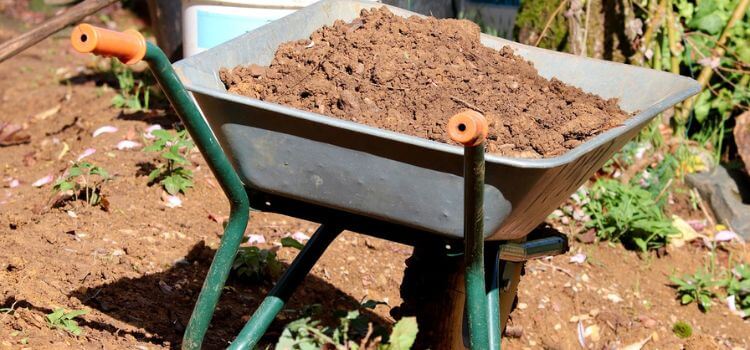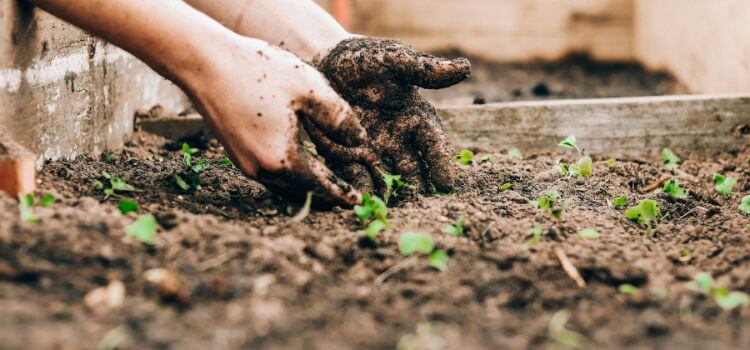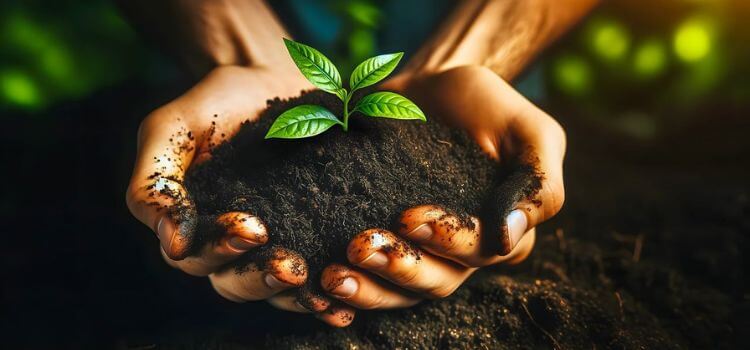As an Amazon Associate, I earn from qualifying purchases.
Potting soil is formulated for container plants. Garden soil is used for outdoor garden beds.
Potting soil and garden soil have distinct uses and benefits. Potting soil is lightweight and sterile and designed for optimal drainage and aeration in containers. Garden soil is denser, often containing organic matter, and enhances outdoor garden beds’ natural soil. Choosing the proper soil type impacts plant health and growth.
Container plants thrive in potting soil due to its tailored nutrients and structure. Garden soil improves garden beds by enriching the existing soil. Understanding their differences ensures better gardening results. Proper soil selection is crucial for successful gardening. Whether gardening indoors or outdoors, using the appropriate soil type fosters healthier plants.
What Is Potting Soil?
Choosing the suitable soil is essential for plant health. Potting soil and garden soil serve different purposes. Understanding what potting soil is helps you make the right choice for your plants.

Composition
Potting soil is a blend of materials designed for container gardening. Unlike garden soil, it doesn’t contain dirt. Instead, it usually includes:
- Peat moss – Retains moisture and aerates the soil
- Perlite – Improves drainage and prevents compaction
- Vermiculite – Enhances moisture retention
- Compost – Provides nutrients and organic matter
- Coir fibre – Sustainable alternative to peat moss
Some potting soils also contain fertilizers and other additives to support plant growth. The exact composition can vary based on the brand and intended use.
Here’s a comparison table for better understanding:
| Component | Purpose |
|---|---|
| Peat Moss | Moisture retention and aeration |
| Perlite | Improves drainage |
| Vermiculite | Enhances moisture retention |
| Compost | Provides nutrients |
| Coir Fiber | Sustainable moisture retention |
These ingredients create a lightweight and nutrient-rich medium ideal for container plants.
Benefits
Potting soil offers several benefits for container gardening:
- Improved Drainage: Prevents waterlogging and root rot
- Better Aeration: Ensures roots get enough oxygen
- Nutrient-Rich: Often pre-fertilized for optimal growth
- Consistent Quality: Uniform texture and components
- Sterile Medium: Free from weeds, pests, and diseases
These benefits make potting soil perfect for indoor plants, hanging baskets, and container gardens. The sterile nature ensures plants grow in a healthy environment without competition from weeds.
Potting soil also allows for better control over the growing conditions. Gardeners can adjust the soil mix to meet specific plant needs, enhancing growth and productivity.
What Is Garden Soil?
When it comes to growing plants, the choice between potting soil and garden soil can be confusing. Each type of soil serves a different purpose and has unique characteristics. Understanding what garden soil is can help you make better decisions for your gardening needs.

Composition
Garden soil is natural soil found in gardens and outdoor spaces. It consists of a blend of sand, silt, and clay, each of which plays a crucial role in the soil’s texture and fertility.
- Sand: Provides good drainage and aeration but lacks nutrients.
- Silt: Holds moisture well and contains nutrients, making it fertile.
- Clay: Rich in nutrients but can retain water, leading to poor drainage.
Garden soil also contains organic matter, such as decomposed plants and animal materials. This organic matter is essential for providing plant nutrients and improving soil structure. Microorganisms in garden soil help break down organic matter, releasing nutrients that plants can absorb.
Here is a quick overview in a table:
| Component | Function |
|---|---|
| Sand | Improves drainage |
| Silt | Holds moisture and nutrients |
| Clay | Rich in nutrients but poor drainage |
Benefits
Garden soil offers several advantages for outdoor gardening. Natural nutrients in the soil, which come from the organic matter and minerals present in it, promote healthy plant growth.
Another benefit is the cost-effectiveness. Garden soil is often freely available in your yard, making it a budget-friendly option. It is also ideal for improving soil structure. Adding compost or other organic matter can enhance its fertility and drainage capabilities.
Garden soil supports a wide range of plants. It can be modified to suit specific plant needs by adding amendments like compost, sand, or peat moss, making it versatile for different types of gardens.
Here are some key benefits:
- Natural nutrients for healthy plants
- Cost-effective and readily available
- Improves soil structure with amendments
- Supports a wide range of plants
Using garden soil can make gardening more sustainable and eco-friendly. Improving your soil reduces the need for commercial products, helping the environment.
Differences Between Potting Soil And Garden Soil
When growing plants, choosing suitable soil is crucial. Potting soil and garden soil have distinct differences that can impact plant growth.
Ingredients
Potting soil and garden so you select event ingredients. Potting soil is a mix of various components designed to create an ideal growing environment for potted plants. It includes:
- Peat moss: Retains moisture and adds organic matter.
- Perlite: Improves aeration and drainage.
- Vermiculite: Enhances water retention and nutrient absorption.
- Compost: Provides essential nutrients.
Garden soil is natural soil from the ground. It is a mixture of sand, silt, clay, and organic matter. The exact composition can vary based on location. Unlike potting soil, garden soil may contain:
- Rocks and debris Can impede plant growth.
- Weeds and pests: Potentially harmful to plants.
- Microorganisms: Beneficial but can also include harmful pathogens.
Texture And Drainage
The texture and drainage of potting soil and garden soil differ significantly. Potting soil is light and fluffy. It allows for excellent drainage, which is vital for potted plants. This texture ensures that water doesn’t stagnate, preventing root rot.

On the other hand, garden soil can have varying textures:
- Sandy soil: Drains quickly but doesn’t retain moisture well.
- Clay soil: Retains water but drains poorly and can be heavy and compacted.
- Loamy soil: A balanced mix of sand, silt, and clay, providing good drainage and moisture retention.
Drainage is crucial for plant health. Poor drainage in garden soil can lead to soggy roots. In contrast, potting soil’s superior drainage makes it ideal for containers.
Nutrients
Nutrient content is another crucial difference. Potting soil is often fortified with nutrients to support plant growth. These nutrients can include:
- Nitrogen: Promotes leaf growth.
- Phosphorus: Encourages root development.
- Potassium: Enhances overall plant health.
Garden soil’s nutrient content varies widely. It depends on the soil’s origin and organic matter content. While rich garden soil can be highly fertile, poor garden soil may require amendments to support plant growth.
Here’s a comparison table for clarity:
| Soil Type | Primary Nutrients |
|---|---|
| Potting Soil | Nitrogen, Phosphorus, Potassium |
| Garden Soil | Varies widely, may need amendments |
Ph Level
The pH level of the soil affects nutrient availability. Potting soil is usually pH-balanced to suit a wide range of plants. Most potting soils have a pH level between 5.5 and 7.0. This range is suitable for most houseplants and garden plants.
Garden soil pH can vary greatly:
- Acidic soil: pH below 7.0, expected in areas with high rainfall.
- Alkaline soil: pH above 7.0, found in arid regions.
Testing garden soil pH is essential. It helps determine if amendments are needed. Lime can raise pH, making the soil less acidic, while sulfur can lower pH, making the soil more acidic.
In summary, understanding the differences in ingredients, texture and drainage, nutrients, and pH levels between potting soil and garden soil helps make the right choice for your plants.
When To Use Potting Soil
Choosing the suitable soil is crucial for the success of your plants. Potting soil and garden soil serve different purposes. Knowing when to use potting soil will ensure your plants thrive. Potting soil is specially formulated for potted plants and has unique properties that garden soil lacks.
Container Gardening
Potting soil is essential for container gardening. Containers limit root space, making soil quality vital. Potting soil offers several benefits:
- Lightweight and airy: Helps roots breathe and grow.
- Good drainage: Prevents waterlogging and root rot.
- Nutrient-rich: Provides essential nutrients for plant growth.
Garden soil can be too dense for containers. It compacts easily, limiting root growth. Potting soil contains ingredients like peat moss, perlite, and vermiculite. These components ensure the soil remains loose and well-drained.
Here’s a quick comparison:
| Feature | Potting Soil | Garden Soil |
|---|---|---|
| Weight | Light | Heavy |
| Drainage | Excellent | Poor |
| Nutrients | Rich | Varies |
Use potting soil for plants in containers to ensure they get the best start.
Indoor Plants
Indoor plants need potting soil to thrive. Indoor environments differ from outdoor gardens. Potting soil caters to these specific needs:
- Sterilized: Free from pests and diseases.
- Moisture retention: Keeps plants hydrated without waterlogging.
- Balanced pH: Suitable for a variety of houseplants.
Poor light and airflow often cause indoor plants to suffer. Potting soil helps mitigate these issues. It supports healthy root systems and ensures proper air circulation.
Garden soil may introduce indoor pests and harbour diseases that harm delicate houseplants. Potting soil is formulated to be clean and safe for indoor use.
Here are some indoor plants that benefit from potting soil:
- Spider Plant
- Peace Lily
- Pothos
- Fiddle Leaf Fig
Choose potting soil for your indoor plants to keep them healthy and vibrant.

When To Use Garden Soil
Choosing the suitable soil is crucial for healthy plant growth. The debate between potting soil and garden soil often arises. Knowing when to use garden soil can significantly impact your gardening success. This blog post will guide you on the best scenarios for using garden soil.
Outdoor Gardening
Garden soil is ideal for outdoor gardening. It is rich in nutrients and minerals, making it perfect for plants grown in the ground. Here are some key points to consider:
- Nutrient-rich: Garden soil contains organic matter that provides essential nutrients to plants.
- Soil Structure: It has a good structure that supports root growth and water retention.
- Microbial Activity: It encourages beneficial microbial activity, aiding plant health.
For outdoor gardening, prepare the soil by tilling it. Remove weeds and mix in compost. This enhances soil fertility and structure.
Here’s a simple table to compare garden soil and potting soil for outdoor gardening:
| Aspect | Garden Soil | Potting Soil |
|---|---|---|
| Nutrient Content | High | Moderate |
| Soil Structure | Good for roots | Light and airy |
| Water Retention | Excellent | Good |
Raised Beds
Raised beds are popular in modern gardening. They offer better control over soil quality and drainage. Garden soil, especially when mixed with compost, is a good choice for filling raised beds.
Benefits of Using Garden Soil in Raised Beds:
- Cost-Effective: Garden soil is cheaper than potting soil.
- Nutrient-Rich: It provides essential nutrients for plant growth.
- Improved Drainage: Mixing garden soil with compost enhances drainage.
For raised beds, follow these steps:
- Prepare the Bed: Start with a layer of cardboard or newspaper at the bottom.
- Add Garden Soil: Fill the bed halfway with garden soil.
- Mix in Compost: Add compost to the garden soil to enhance nutrient content.
- Level the Soil: Smooth the soil surface and water it lightly.
Using garden soil in raised beds ensures a strong foundation for your plants. Thanks to the rich nutrients and improved soil structure, they will grow healthy and robust.
What’s The Right Soil For Your Plants?
Choosing the suitable soil for your plants is crucial for their health and growth. The debate between potting soil and garden soil often confuses gardeners. Each type has its unique properties and uses. Understanding the differences can help you make an informed decision and give your plants the best possible start.
Considerations
Several factors play a crucial role in selecting soil. Potting soil is light and fluffy, designed to provide good drainage and aeration. Garden soil, on the other hand, is denser and may contain clay, sand, and silt.
Here are some considerations:
- Plant Type: Some plants thrive in garden soil, while others need potting soil.
- Location: Use potting soil for containers and garden soil for outdoor beds.
- Drainage: Potting soil drains well, preventing root rot. Garden soil may need amendments for better drainage.
- Nutrient Content: Potting soil is often enriched with nutrients. Garden soil may need compost or fertilizers.
Here’s a quick comparison:
| Feature | Potting Soil | Garden Soil |
|---|---|---|
| Texture | Light and Fluffy | Dense and Heavy |
| Drainage | Excellent | Variable |
| Use | Containers | Garden Beds |
| Nutrient Content | Rich | May Need Amendments |
Mixing Soils
Sometimes, mixing potting soil with garden soil can offer the best of both worlds. This can create a balanced environment for your plants, combining the drainage and aeration of potting soil with the nutrient content and structure of garden soil.
Steps to mix soils:
- Determine the Ratio: A usual mix is 1 part potting soil to 2 parts garden soil.
- Combine Thoroughly: Mix the soils until well-blended.
- Test the Mixture: Check for good drainage and texture.
- Adjust as Needed: Add more potting soil for better drainage or garden soil for added nutrients.
Benefits of mixing soils:
- Improved Drainage: Potting soil helps prevent waterlogging.
- Enhanced Nutrients: Garden soil adds organic matter.
- Cost-Effective: Mixing can be more economical than using only potting soil.
Mixing soils can be ideal for raised beds and large containers. It offers a balanced solution for many plants.

Frequently Asked Questions On Potting Soil Vs Garden Soil
It is not recommended to use garden soil in pots. It lacks proper drainage and can compact, harming plant roots. Use potting soil instead.
Mix garden soil with compost, perlite, and peat moss. Sterilize the mixture to eliminate pests. Ensure proper drainage. Adjust pH if needed.
Potting mix offers better drainage and aeration than garden soil. It is free from pests, diseases, and weed seeds. Potting mix contains essential nutrients tailored for container plants, ensuring healthier growth. Garden soil can be heavy and compact, which may hinder root development.
Yes, there’s a significant difference. In-ground soil is natural and varies by location. Potting soil is specifically formulated for containers, providing better drainage and nutrients.
Conclusion
Choosing between potting and garden soil depends on your plant’s needs and environment. Potting soil offers better drainage and aeration for container plants, while garden soil enriches outdoor gardens with essential nutrients. Understanding the differences ensures healthier plants and a more successful gardening experience.
Happy gardening!

